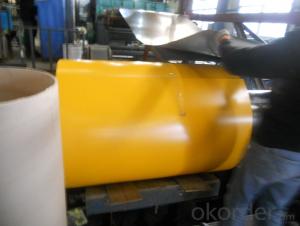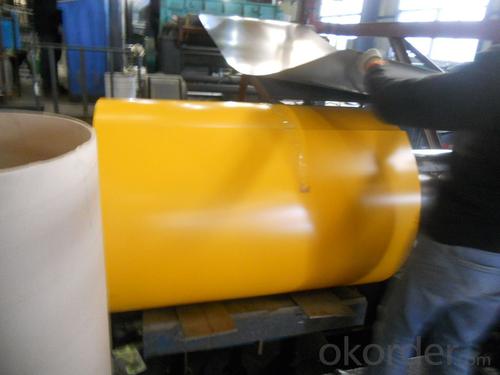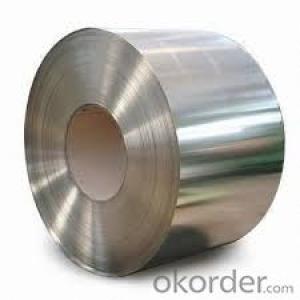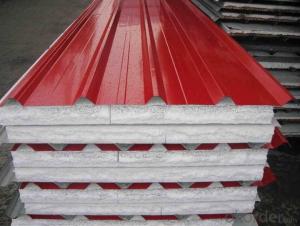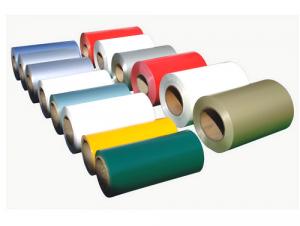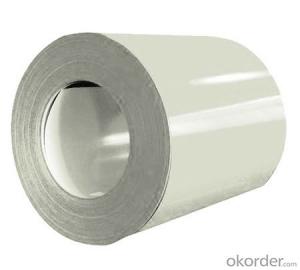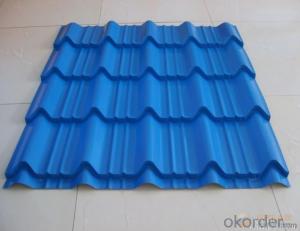PREPAINTED GALVANISED STEEL IN COIL
- Loading Port:
- China Main Port
- Payment Terms:
- TT OR LC
- Min Order Qty:
- -
- Supply Capability:
- -
OKorder Service Pledge
OKorder Financial Service
You Might Also Like
Product Description:
Prepainted galvanized color coated PPGI steel:
| Thickness | 0.12-1.2mm |
| Width: | 700-1250mm |
| Material: | SGCC,SGCD,SECC,SECD,DX51D+Z |
| Zinc coating: | 30-180G/M2 |
| Surface Structure: | galvanized ,zero spangle, regular spangle or normal spangle |
| COLOR: | RAL number or sample colour |
| Coating: | Topside: 5micron primer +15-20microns polyester Backside: 5-8microns primer epoxy. Surface treatment: chromated and oiled, chromated and non-oiled |
II Main characteristics :
1.strong corrosion resistance
2.surface quality
3.conducive to deep processing,such as corrugated steel sheet 4.economy and practicality
III Applications:
Household Appliance:
1.Refrigerator shutter &side panels, Washer, Freezers, Air conditions,
2.Rice Cooker, Microwave Ovens, Water Heaters, Sterilization Cabinets, Range Hoods
3.Computer Panels , DVD/DVB panels, TV back panel etc.
- Q: How are steel coils tested for mechanical properties?
- Steel coils are tested for mechanical properties through various methods, including tension testing, hardness testing, and impact testing. Tension testing involves applying force to the coil until it breaks, allowing for the measurement of its strength and elongation. Hardness testing determines the coil's resistance to indentation, providing insight into its overall strength and durability. Impact testing determines the coil's ability to withstand sudden applied loads by subjecting it to a high-velocity impact and measuring its ability to absorb the energy. These tests help ensure that steel coils meet the required mechanical properties for their intended applications.
- Q: What are the common quality control measures for steel coils?
- There are several common quality control measures that are implemented for steel coils to ensure their performance and reliability. These measures are crucial in maintaining the overall quality of the steel coils and ensuring that they meet the required standards and specifications. Firstly, dimensional checks are conducted to ensure that the steel coils have the correct thickness, width, and length. This is important as any deviations from the specified dimensions can greatly affect the performance and usability of the coils. Next, visual inspections are carried out to identify any surface defects or imperfections such as scratches, dents, or corrosion. These inspections help in identifying any potential issues that may compromise the structural integrity of the coils or affect their aesthetic appearance. Furthermore, mechanical property tests are conducted to determine the strength, hardness, and other mechanical characteristics of the steel coils. These tests help in assessing the performance and durability of the coils under different conditions and loads. Chemical composition analysis is also an important quality control measure for steel coils. This involves analyzing the composition of the steel, including the presence of any impurities or elements that may affect its properties. It ensures that the steel coils are made from the correct grade and meet the required chemical specifications. Coating inspections are another vital quality control measure. If the steel coils are coated with protective layers, it is essential to check the adhesion, thickness, and uniformity of the coatings. This helps in ensuring that the coils have adequate protection against corrosion and other environmental factors. Lastly, various non-destructive testing methods such as ultrasonic testing, magnetic particle inspection, or eddy current testing are employed to identify any internal defects or abnormalities in the steel coils. These tests help in detecting issues such as cracks, inclusions, or discontinuities that are not visible through visual inspection. Overall, the common quality control measures for steel coils include dimensional checks, visual inspections, mechanical property tests, chemical composition analysis, coating inspections, and non-destructive testing. These measures are essential in maintaining the quality and reliability of steel coils and ensuring that they meet the required standards and customer expectations.
- Q: Can steel coils be coated with anti-static materials?
- Yes, steel coils can be coated with anti-static materials to help reduce or eliminate static electricity buildup and discharge. Anti-static coatings are commonly applied to various surfaces, including metals, to prevent damage to sensitive electronic components, improve safety, and enhance overall product performance.
- Q: How are steel coils inspected for oil or rust residues using chemical analysis?
- Steel coils can be inspected for oil or rust residues using chemical analysis by first collecting samples from various parts of the coil. These samples are then analyzed using appropriate chemical techniques such as solvent extraction or acid digestion to extract any oil or rust residues present. The extracted substances can be further analyzed using methods like Fourier transform infrared spectroscopy (FTIR) or atomic absorption spectroscopy (AAS) to identify and quantify the specific contaminants. This chemical analysis allows for a thorough inspection of steel coils and helps ensure their quality and suitability for various applications.
- Q: How are steel coils processed for heat treatment?
- Steel coils are typically processed for heat treatment by first being cleaned and prepped to remove any contaminants. They are then heated to a specific temperature and held at that temperature for a predetermined amount of time. After the desired heat treatment process is completed, the coils are cooled down gradually to ensure they retain the desired properties.
- Q: Can steel coils be coated with vibration-damping materials?
- Yes, steel coils can be coated with vibration-damping materials.
- Q: What website can I use to find a good picture that shows the atomic structure of a carbon steel?
- This Site Might Help You. RE: Where can I find an atomic structure of carbon steel? What website can I use to find a good picture that shows the atomic structure of a carbon steel?
- Q: We have to do a project for school on steel mines and i need 4 PROPERTIES OF A STEEL MINE PLEASE HELP!!! URGENT!!!
- There's no such thing as a Steel mine - steel is made from various raw materials (and now recycled metals). These materials may be mined separately and then combined at a steel mill - but steel is made, not mined. Steel, depending on what final characteristics they're trying to develop (strength, hardness, finish , etc.) can be comprised of iron, carbon, manganese, phosphorus, sulfur, nickel, chromium, etc. in varying quantities.
- Q: What are the different methods of coil handling and storage?
- There are several different methods of coil handling and storage that are commonly used in various industries. These methods are designed to ensure the safe and efficient handling of coils, as well as their storage to prevent damage and maintain their quality. Some of the different methods include: 1. Coil cradles: Coil cradles are a popular method of handling and storing coils. They are typically designed with a U-shaped structure that provides support and stability to the coil. The cradle is placed beneath the coil, and it can be easily moved using forklifts or overhead cranes. 2. Coil cars: Coil cars are used to transport coils within a facility or from one location to another. They are equipped with special clamps or arms that securely hold the coil during transportation. Coil cars can be operated manually or automatically, depending on the size and weight of the coils. 3. Coil racks: Coil racks are storage systems that are specifically designed for storing coils in an organized manner. These racks are typically made of steel and have multiple levels or compartments to accommodate different sizes and types of coils. Coil racks can be accessed using forklifts or overhead cranes. 4. Coil turnstiles: Coil turnstiles are rotating devices that allow for easy loading and unloading of coils. They are often used in processing lines where coils need to be continuously fed into machines. The turnstile rotates the coil to the desired position, making it easier to handle and process. 5. Coil pallets: Coil pallets are specially designed pallets that are used to store and transport coils. They are typically made of steel or wood and have a unique configuration that allows for easy loading and unloading of coils using forklifts or pallet jacks. Coil pallets are often used when coils need to be transported long distances or stored in warehouses. 6. Coil storage racks: Coil storage racks are large storage systems that are specifically designed to store coils in bulk. These racks are typically made of steel and have multiple levels or compartments to accommodate a large number of coils. Coil storage racks can be accessed using forklifts or overhead cranes. These are just some of the different methods of coil handling and storage that are commonly used in various industries. The specific method used will depend on factors such as the size and weight of the coils, the available space, and the specific requirements of the industry.
- Q: How are steel coils used in the manufacturing of automotive suspension systems?
- Steel coils are used in the manufacturing of automotive suspension systems as they provide the necessary support and flexibility to absorb shocks and vibrations. These coils are typically placed between the vehicle's frame and the axle, allowing the suspension to compress and rebound when encountering bumps or uneven terrain. By absorbing and distributing the impact forces, steel coils ensure a smoother and more comfortable ride for the passengers while also enhancing the vehicle's stability and handling capabilities.
Send your message to us
PREPAINTED GALVANISED STEEL IN COIL
- Loading Port:
- China Main Port
- Payment Terms:
- TT OR LC
- Min Order Qty:
- -
- Supply Capability:
- -
OKorder Service Pledge
OKorder Financial Service
Similar products
Hot products
Hot Searches
Related keywords
